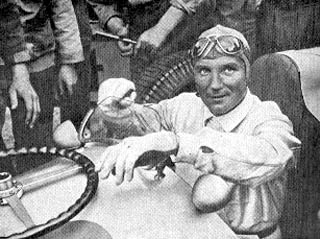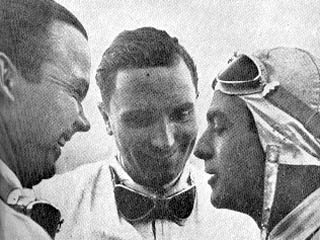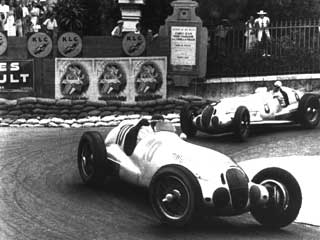 THE MONACO GRAND PRIX LIBRARY BY ROY HULSBERGEN THE MONACO GRAND PRIX LIBRARY BY ROY HULSBERGEN |
|||||||||||||||||||||
 |
Manfred von Brauchitsch |
By Paul Frère | |||||||||||||||||||
|
Tweet |
|||||||||||||||||||||
Born: 15 August 1905, Hamburg, Germany
In 1932, Mercedes-Benz felt the old SSKL could not compete any more with the much more agile Alfas and Bugattis, but Brauchitsch had no choice and struggled on. He had his eye on a race to be staged in Berlin on the AVUS track where a very high top speed was essential. For this, he persuaded the famous aerodynamics, Freiherr von Koenig Fachsenfels to design a streamlined body for his car, now an SSKL ( L standing for Lightweight, which was very relative! ) and managed to beat Caracciola, now driving for Alfa-Romeo, by 2 seconds ! This made him a star overnight and since he was a 27 years old handsome young man, he was immediately contracted to play the main role in a film in which he starred as a racing driver. But he found acting rather boring and soon had better things on his agenda. In 1934 Mercedes was back in racing and asked him to be one of the team drivers together with Caracciola and Fagioli. Here again, success was immediate: driving the new W125, built for the 750kg formula, von Brauchitsch won the car’s maiden race, the Eifelrennen, easily beating Hans Stuck Sr.’s rival mid-engined Auto Union. Then more than two years without a major success were to follow. Brauchitsch was a very fast driver. His style was flamboyant, he revelled in spectacular power slides, which made him a favourite with the crowds, but his style was tough on the car and rough on the tyres. He should have won the German Grand Prix twice: once in 1935, when one of his rear tyres burst 5 km from the finish and Nuvolari went through to win for Alfa Romeo, and in 1937, when his car caught fire when refuelling for the last time, giving team made Dick Seaman his chance. Only twice did he win what, at the time, was called a “Grande Epreuve”: the Monaco Grand Prix of 1937 after a titanic fight with Caracciola, and in 1938 the French Grand Prix on the Rheims circuit. The 1939 Yugoslav Grand Prix, a street race in Belgrade, was staged on the day Germany declared war and invaded Poland. After finishing 2nd in that race, Brauchitsch jumped into a plane to fly to Switzerland. But somehow, team Chief Alfred Neubauer had been informed and literally minutes before take-off, he was pulled out of the plane. After the war, Brauchitsch tried to resume racing, but soon gave up when he did not find a car matching his ambitions. And when Mercedes-Benz made its come-back in 1954, he had crossed the border to live in East Germany where, for a few years, he was the President of the DDR’s Olympic Committee. On August 15, 1995, he was invited by Mercedes-Benz to a superb 90th birthday party, where he appeared in top form and made a speech in which he recalled both his career and the more controversial side of his life with a splendid sense of humour. |
|
||||||||||||||||||||
|
|||||||||||||||||||||




